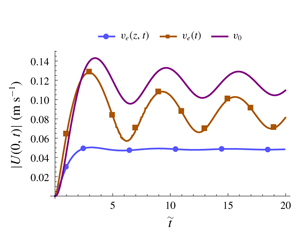Article contents
Upper-ocean Ekman current dynamics: a new perspective
Published online by Cambridge University Press: 28 January 2020
Abstract

The work examines upper-ocean response to time-varying winds within the Ekman paradigm. Here, in contrast to the earlier works we assume the eddy viscosity to be both time and depth dependent. For self-similar depth and time dependence of eddy viscosity and arbitrary time dependence of wind we find an exact general solution to the Navier–Stokes equations which describes the dynamics of the Ekman boundary layer in terms of the Green’s function. Two basic scenarios (a periodic wind and an increase of wind ending up with a plateau) are examined in detail. We show that accounting for the time dependence of eddy viscosity is straightforward and that it substantially changes the ocean response, compared to the predictions of the models with constant-in-time viscosity. We also examine the Stokes–Ekman equations taking into account the Stokes drift created by surface waves with an arbitrary spectrum and derive the general solution for the case of a linearly varying with depth eddy viscosity. Stability of transient Ekman currents to small-scale perturbations has never been examined. We find that the Ekman currents evolving from rest quickly become unstable, which breaks down the assumed horizontal uniformity. These instabilities proved to be sensitive to the model of eddy viscosity, they have small ( ${\sim}10^{2}~\text{m}$) spatial scales and can be very fast compared to the inertial period, which suggests spikes of dramatically enhanced mixing localized in the vicinity of the water surface. This picture is incompatible with the Ekman paradigm and thus prompts radical revision of the Ekman-type models.
${\sim}10^{2}~\text{m}$) spatial scales and can be very fast compared to the inertial period, which suggests spikes of dramatically enhanced mixing localized in the vicinity of the water surface. This picture is incompatible with the Ekman paradigm and thus prompts radical revision of the Ekman-type models.
- Type
- JFM Papers
- Information
- Copyright
- © The Author(s), 2020. Published by Cambridge University Press
References
- 16
- Cited by




